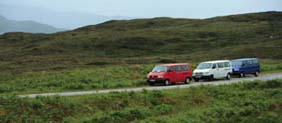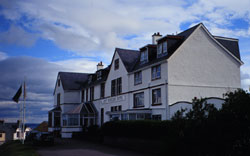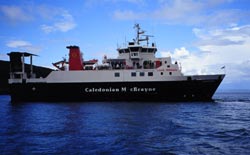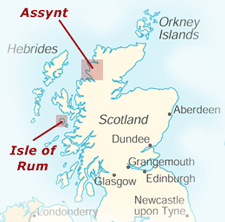Study Tour
Scotland
This year's annual geodynamics field trip was to Scotland, where students and faculty visited
the Isle of Rum and the Loch Assynt region.
Rum is one of the Small Isles south of the Isle of Skye, and is a renowned nature preserve now owned by the Scottish Natural Heritage. We stayed in a remarkable Victorian castle for 4 nights while hiking the island's trails. The Rum layered intrusion site is famous for its spectacular melt-rock interaction features, including magmatic sedimentation, dissolution fronts, channeling, stoped roof rock blocks of gabbro draped by magmatic sediments, layering and a host of wonderful features.
Following Rum we returned to the mainland and drove to the Loch Assynt region of NW Scotland, where we examined a host of different aspects of Scottish geology, including the famous Moine Thrust.
Journey
Our group of 15 (10 students, 1 post-doc, and 4 faculty) departed Boston on June 8th on a jumbo jet
for Glasgow, Scotland. The personal space afforded coach class travelers on our flight was insulting, and we arrived the following morning completely devastated. Nevertheless we had but a short time to observe the myriad geological wonders of Scotland, so immediately upon our arrival we began driving north to the port of Mallaig where we would catch the ferry to Rum the next day. We must have looked the patriotic lot in our red, white, and blue microvans, but had the mental state of our drivers been known to the locals they would surely have given us more space on the two lane highways. Imagine our surprise when we tried to downshift and lowered the window instead.
Everybody knows that nothing can stand in the way of geological processes, and thusly motivated we put aside jet lag and had a look at Glencoe, a Devonian volcanic center with a famous history of ingratitude and bad manners.
What's a Devonian volcanic center? In this case just a bit of rhyolitic magmatism generated by the collision of the Avalon and Laurentia continents some 400 million years ago. Scotland has a fascinating geological history, and in fact it can legitimately claim to be the birthplace of modern geological science. If you like your science nice and simple then you can forget ever comprehending the meaning of rocks in Scotland. But if you like things that are complicated and confusing... then you would have liked driving with us up the coast to Mallaig because it wasn't clear from one moment to the next what exactly was happening.
This much is clear, we arrived in Mallaig without an incident that anyone could remember, and fell upon the West Highland Inn with the weight of our fatigue and surprisingly healthy appetites. Eating in Scotland is an experience to be missed, but we did it anyway and then more or less collapsed in heaps.
There was some controversy at the bar as the drinking habits of several members of our group were questioned by the Irish barmaid, who referred to one individual offering to share his beer as "Half Pint", and another with the bad sense to order a glass of port as a "Granny Drinker." On a different day this might have started a brawl, but we were too tired to care about being insulted, and the situation was defused on account of extreme exhaustion.
Our destination the next morning was the Isle of Rum, which was to be our base for about 4 days. We arrived at Rum after a leisurely sail across the channel on the ferry, and descended upon the youth hostel established in historic Kinloch Castle.
Rum is a magnificent island adjacent to the better known Isle of Skye, and we spent the next four days hiking among its peaks, hills, and valleys. The rock outcrops are wonderful and occasionally
spectacular, in the summer the sun sets at about 11:30 pm, but the weather is awful and one must take extreme caution to absolutely never find yourself in a windless space outdoors near sundown lest you be devoured by a swarm of the dreaded midges. Some Scots at our hostel remarked that they'd gladly accept the Euro if Scotland be allowed to export the midge. This must not be allowed to happen.
After four days on Rum we returned to the mainland with our heads full of layered gabbros and bedded peridotites, our bellies full of single highland malts, and our hearts full of dread for the "gentle Scottish climate." All traces of jet lag were now happily absent, and driving, which only a few days earlier had seemed a terrible burden, was now great sport. The Scottish Highlands are ribboned by quaint single lane roads at the extreme north end, and the microbuses happily gobbled up these asphalt pathways.
Eventually we managed to reach Achmelvich Bay in the Assynt region, a sublime testament to the devious character of the Almighty, who deemed it appropriate to put a knocked-out-loaded white sand beach or two in northern Scotland, well out of reach of the European beach circuit. Here again we stayed at a hostel. A nice enough place though the moss in our duffels was starting to go septic. Our nighttime fantasies swirled with hot showers, and clean, dry clothing. You can see the layered sedimentary beds that first gave some geologists an idea of the scope of geological time in Assynt,
but you can't watch World Cup Football on television because there aren't any TVs! This proved a bit frustrating to certain members of our group, but in the end one has to admit that looking at famous rock outcrops in the drizzling rain is no more painful than watching Totti fall to the ground and put his hands to his face in agony because somebody has stepped on his foot.
After several days in the Assynt region it was finally time to turn our thoughts towards home. We drove east to Inverness, stopping along the way to visit the Glenmorangie distillery (try the 18 yr. old brew if you can find it), and abandoned all pretense of cultural immersion by checking into the Holiday Inn. The pre-fab hotel experience never felt so good as we torqued the hot water gauges to maximum and let the manky, wet, clothes dry out on the lampshades.
The next day it was all business as we drove to the airport and took a series of three flights back home. Coach seating about did us in again, but somehow we managed to keep our wits about us and get through U.S. customs. 80% humidity in Boston never felt so dry.

Our patriotic trio of trusty VWs.
(Photo by C.A. Linder)

The West Highland Inn in Mallaig. (Photo by C.A. Linder)

The Caledonian MacBrayne ferry serving the Small Isles.
(Photo by C.A. Linder)

Green Scottish countryside flies by.
(Photo by C.A. Linder)

Joint Program students and staff enjoy a cultural respite.
(Photo by C.A. Linder)
Participants
The field trip to Scotland was led by Peter Clift, Rob Sohn, and Glen Gaetani from WHOI. Mike Cheadle from the University of Wyoming led the excursions on the Isle of Rum. Hover over the names at left to learn about the participants.
Staff
Peter Clift
Mike Cheadle
Rob Sohn
Glen Gaetani
Vitalii Sheremet
Laurent Montesi
Chris Linder
Students
Cara Santelli
Mike Braun
Brian DeMartin
Amy Draut
Marc Hesse
Astri Kvassnes
Emily Van Ark
Jessica Warren
Clare Williams
Loch Assynt Region
After leaving the Isle of Rum the party visited the far NW of Scotland in the region of Loch Assynt. This is a classic region for geological studies dating back to the 18th century. The coastal region exposes some of the oldest rocks in Europe: the 2.8 billion year old Lewisian Gneisses, which were eroded and overlain by a thick sequence of flat-lying red sandstones, the Torridonian Group, which itself spans >300 million years of geological time. At that time these rocks were deposited by rivers on the edge of the North American continent, which broke apart at 600 million years ago (Ma) to form the Iapetus Ocean. As the margins of the continent subsided marine sediments were laid down over the Torridonian, forming the succession of sandstones and limestones now exposed along the shores of Loch Assynt (Pipe Rock, Fucoid Beds, Salterella Grits and Durness Limestones). Click here to read Rob Sohn's poetic tribute to the Durness group.
At 470 Ma the margin of North America collided with a chain of volcanic islands, similar to modern Taiwan, that caused folding and faulting, and the formation of the Appalachian Mountais in the US and Canada and the Grampian Highlands in Scotland. As the final act in this mountain building the rocks of the Assynt region were bulldozed and repeated by a thrust sheet of metamorphosed rocks riding on top of the Moine Thrust. Click here to watch a movie depicting the Moine Thrust at Knockan Crag (note that some players may not display the video - Quicktime works best). This region became a classic example of how rocks deform to compressional deformation and in particular the debate as to whether crystalline rocks were formed under the ocean, or were precipitated from magmatic liquids in the way we understand today.
Click on the slide show to see images from the Loch Assynt field excursions.
Isle of Rum
The Isle of Rum is fascinating from a geological standpoint for four reasons:
- It's a classic layered intrusion... one of the world's best examples of a replenished mafic magma chamber.
- It arguably offers the opportunity to see the 'guts' of a volcano. Could it be that the magma chambers of the
Hawaiian volcanoes look much like this? - It allows us to try and understand the processes that
go on inside a 1000 km3 ultramafic magma chamber. - It's one of the important volcanoes of the British Tertiary Volcanic Province (BTVP).
Dr. Mike Cheadle and Dr. Bobbie John from the University of Wyoming accompanied our MIT/WHOI group into the field, providing expert discussions on the different aspects of Rum geology. Rum is one of the oldest volcanoes in the west of Scotland, pre-dating the centers in
Skye and Mull. Ages close to 63 Ma link this closely to the initation of the Icelandic hotspot, still active today. The gabbros that form the core of the exposed volcano are divided into three sections, two layered series in the East and West and a chaotic central zone, which is inferred to be the feeder
zone where new melt was delivered into the chamber from the underlying mantle.
The gabbros are inferred to represent a 1000 km3 magma chamber and are famous for their rhythmic, layered appearance whose origin has been hotly debated by geologists. One viewpoint
holds that these represent precipitation of crystals in a liquid magma chamber, with each layer representing the arrival of new batch of melt. Others have argued that the chamber was originally
semi-solid and relatively homogeneous, with the banding the result of the late stage injection of a series of gabbroic sills. Click here to read Joint Program student Cara Santelli's series of three
haikus composed in honor of Rum's volcanic past.
On the first day, the group hiked to see the chaotic folding and slumping of the central zone, with time to see the famous long olivine crystals of the Harrisites. More Harrisites were viewed by an elite and dedicated minority on the second day in the face of an unrelenting north Atlantic downpour. On the third day, the heavens smiled on the party enough to allow an inspection of the classic eastern layered series on the slopes of Mt. Hallival.
The accompanying slide shows provide a glimpse at the geology and scenery we encountered on the Isle of Rum.
